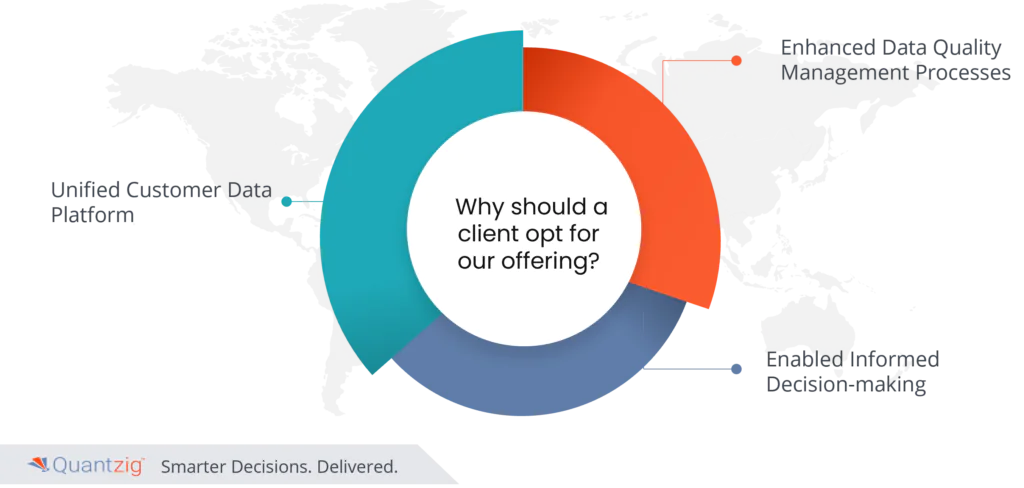Table of Contents
Introduction
In today’s ever-evolving Business Environment, leveraging the power of Customer data is no longer optional, it’s imperative. Welcome to the era of customer analytics 3.0, a revolutionary paradigm shift that will revolutionize the way businesses view, engage with, and deliver for their customers.
Before we get into strategies, it’s important to understand how customer analytics has evolved:
Customer Analytics 1.0 – Introduced basic customer data analysis to create marketing segmentation.
Customer Analytics 2.0 – Introduced advanced analytics powered by machine learning to create personalized experiences.
Customer Analytics 3.0 – Uses Artificial Intelligence and real-time data processing to provide comprehensive, immediate customer insights, transforming decision-making.
In this era, where customer expectations evolve rapidly, Customer Analytics 3.0 is the key to agility and innovation. It empowers you to elevate personalization, make agile decisions, drive innovation, and optimize resources. Join us on this journey to explore strategies that will redefine your organization’s approach to understanding, engaging, and delighting customers in the data-centric future.
Request a demo to experience the meaningful insights we derive from data through our analytical tools and platform capabilities. Schedule a demo today!
Request a Free Demo
Importance of Success Strategies for Implementing Customer Analytics 3.0 in Organization
Success strategies for implementing Customer Analytics 3.0 in an organization hold paramount importance in today’s dynamic business landscape. Here are five crucial reasons why prioritizing these strategies is essential:
1. Enhanced Customer Insights:
Implementing Customer Analytics 3.0 enables organizations to gain deep insights into customer behavior, preferences, and interactions across various touchpoints. By analyzing numerical data and qualitative information derived from sources like web analytics, social listening, and customer surveys, businesses can develop a comprehensive understanding of their customer base. These insights empower companies to tailor their products, marketing content, and sales funnels to meet customer needs effectively, resulting in improved customer satisfaction and long-term brand loyalty.
2.Optimized Marketing Campaigns:
Customer Analytics 3.0 equips organizations with the tools and metrics needed to refine their marketing strategies for maximum impact. By leveraging data-driven insights, businesses can create highly targeted campaigns that resonate with specific customer segments. Through techniques such as user journey design and segmentation, companies can deliver personalized marketing content and promotions to enhance customer engagement and drive conversions. This approach ensures that marketing efforts are focused, efficient, and aligned with overall business objectives, ultimately yielding tangible results and ROI.
3. Improved Product Experience:
Customer Analytics 3.0 facilitates a deeper understanding of product usage and customer habits, enabling organizations to enhance product experience (PX) and drive repeat purchases. By analyzing adoption metrics and customer feedback, businesses can identify areas for improvement and innovation, ensuring that their products meet and exceed customer expectations. Additionally, insights derived from Session Recordings, Heatmaps, and user surveys enable organizations to address problems and pain points promptly, fostering a positive user experience and bolstering customer satisfaction.
4. Data-Driven Decision Making:
Implementing Customer Analytics 3.0 enables organizations to make informed, data-driven decisions across all levels of the business. By leveraging hard statistics and quantitative data, companies can identify trends, patterns, and correlations that inform strategic management decisions. This approach minimizes risks, optimizes resource allocation, and maximizes return on investment (ROI). Moreover, by fostering a culture of collaboration and communication among teams, organizations can ensure that insights gleaned from customer analytics are effectively utilized to drive business growth and success.
5. Competitive Advantage:
In today’s competitive landscape, organizations that harness the power of Customer Analytics 3.0 gain a significant competitive advantage. By staying abreast of retail trends, customer segment preferences, and market dynamics, businesses can adapt quickly to changing consumer needs and preferences. This agility enables organizations to stay ahead of the curve, outperform competitors, and maintain market leadership. Moreover, by continuously testing and iterating on their customer analytics strategies, companies can remain agile and responsive, ensuring continued relevance and success in an ever-evolving business environment.
In conclusion, the implementation of success strategies for Customer Analytics 3.0 is crucial for organizations looking to thrive in today’s data-driven, customer-centric landscape. By harnessing the power of advanced analytics techniques, leveraging data-driven insights, and fostering a culture of innovation and collaboration, businesses can unlock a myriad of benefits, ranging from enhanced customer insights and optimized marketing campaigns to improved product experiences and sustainable competitive advantage.
Challenges/Problems faced while implementing Success Strategies for Customer Analytics 3.0 in Organization
1. Multi-Channel Data Integration
In today’s business world, customer interactions take place across numerous channels, from websites to mobile apps to social media to stores. All of these channels generate data in a variety of formats, so it can be difficult to comprehend all the different ways customers interact with your business. To get the most out of customer analytics strategy, you need to ensure that data from all of these channels is included in your analytics program, so you can obtain a complete view of your customers’ behavior.
2. Structured and Unstructured Data Processing
Customer data is increasingly comprised of unstructured data such as text from customer reviews, photos, videos, and audio recordings, as well as structured data such as names and purchase histories. The combination of structured and unstructured data requires sophisticated data processing and analysis methods to extract useful insights. To find hidden patterns and customer preferences, businesses must invest in tools and technology that can effectively analyze and analyze unstructured data.
3. Data Accuracy, Attribution, and Compliance
Customer analytics 3.0 recommendations and strategies are largely dependent on accuracy and attribution. If the data is not accurate, it may lead to inaccurate conclusions, and if the data is not correctly attributed, it could lead to inaccurate recommendations. Organizations must also comply with complex data privacy regulations such as GDPR, CCPA, and other regulations that require strict data handling.
Benefits of Success Strategies for implementing Customer Analytics 3.0 in Organization
Implementing Customer Analytics 3.0 within an organization yields multifaceted benefits that transcend mere data analysis. Beyond optimizing business strategies, this approach fosters a customer-centric mindset, enhancing every aspect of the customer journey and experience. Here are four additional benefits of adopting success strategies for Customer Analytics 3.0:
1. Enhanced Customer Value and Profitability
Customer Analytics 3.0 allows organizations to reach the bottom of individual customer profiles, discovering more about their preferences, behaviors and needs. With this level of granularity, organizations can create personalized strategies. By customizing product recommendations, marketing communications and service offerings to match each customer’s preferences, organizations can drive high ROI behaviors. This translates into higher customer spending, better average transaction values and higher frequency of purchases. This leads to a significant increase in customer lifetime values (CLLs) and profitability because customers feel valued and involved, resulting in a favorable outcome.
2. Superior Customer Retention
In today’s highly competitive market, customer loyalty and retention are at the top. By utilizing the power of customer analytics strategy, organizations can acquire new customers and retain existing ones more efficiently. By providing personalized, contextually relevant experiences that foster deeper emotional connections, organizations can not only reduce churn rates but also encourage customers to move to higher-value offerings within the organization’s portfolio. As a result, customer retention rates increase, resulting in sustainable revenue streams and a long-term market success.
3. Enhanced Personalization Strategy
With a robust customer analytics strategy in place, businesses can delve deep into customer data, gaining insights into their preferences, behaviors, and journey across various touchpoints. By leveraging advanced tech tools and GenAI algorithms, companies can segment their customer base effectively and tailor personalized experiences at every interaction. This targeted approach not only boosts customer satisfaction but also drives conversion rates by delivering relevant content and recommendations, aligning with each customer’s unique needs and preferences.
4. Optimized Marketing Campaigns
Customer Analytics 3.0 empowers organizations to create data-driven marketing campaigns that resonate with their target audience. By analyzing customer data and understanding their buying behavior, businesses can design highly targeted campaigns that are more likely to yield positive outcomes. Whether through social media channels, email marketing, or other online platforms, leveraging customer analytics enables companies to craft messages and offers that are timely, relevant, and impactful. This optimization not only improves the efficiency of marketing efforts but also maximizes ROI by focusing resources on high-potential segments and channels.
5. Compliance with Customer Privacy Regulations
In an era of stringent customer privacy regulations, maintaining compliance is paramount for businesses. By utilizing Customer Analytics 3.0, organizations can navigate the complex landscape of customer data while ensuring adherence to regulations such as GDPR and CCPA. Through careful management and secure handling of customer data, businesses can build trust with their clientele, safeguarding their privacy and earning their loyalty. By integrating privacy considerations into their customer analytics tech stack, companies demonstrate a commitment to ethical data practices, mitigating the risks associated with data breaches and regulatory non-compliance.
6. Insights into Product Experience and Usage
Beyond understanding customer behavior and preferences, Customer Analytics 3.0 offers valuable insights into product usage and experience. By analyzing data on product interactions, features utilization, and feedback, businesses can identify areas for improvement and innovation, enhancing the overall product experience. Whether through feedback loops, user surveys, or in-app analytics, capturing product usage insights enables companies to iterate rapidly, aligning their offerings with customer expectations and market demands. This iterative approach fosters continuous improvement, driving customer satisfaction and loyalty while maximizing the value delivered by products and services.
Implementing success strategies for Customer Analytics 3.0 empowers organizations to unlock a myriad of benefits, ranging from enhanced personalization and optimized marketing campaigns to compliance with privacy regulations and insights into product experience. By harnessing the power of data-driven decisions and customer-centric mindset, businesses can navigate the complexities of the modern marketplace with confidence, driving sustainable growth and competitive advantage.
Experience the advantages firsthand by testing a customized complimentary pilot designed to address your specific requirements. Pilot studies are non-committal in nature.
Request a Free Pilot5 steps to develop and implement a customer analytics plan
Developing and implementing a robust customer analytics plan is essential for businesses aiming to optimize their operations and enhance customer satisfaction. Here are five steps to guide you through the process:
1. Define Your Customer Analytics Strategy:
Begin by outlining clear objectives and goals for your customer analytics plan. Identify key areas of focus such as improving the customer experience across various touchpoints or enhancing product usage insights. Align these objectives with your overarching business strategy to ensure coherence and relevance. Consider incorporating key performance indicators (KPIs) to measure the effectiveness of your initiatives. With a well-defined customer analytics strategy in place, you can lay the groundwork for data-driven decisions that drive meaningful outcomes.
2. Collect Relevant Customer Data:
Leverage a variety of tech tools to gather data from diverse sources, including online platforms, social media, and customer interactions. This comprehensive approach allows you to capture insights throughout the customer journey and understand customer buying behavior more deeply. Ensure compliance with customer privacy regulations and prioritize ethical data practices to safeguard customer trust and privacy. By collecting and analyzing a broad spectrum of data, you can gain a holistic view of your customers and their preferences.
3. Utilize Advanced Analytics Techniques:
Implement a robust customer analytics tech stack equipped with advanced analytics capabilities, including GenAI algorithms for predictive analysis and segmentation. Leverage these tools to extract actionable insights from your data, such as identifying patterns in product usage or predicting conversion rates. By harnessing the power of advanced analytics, you can uncover hidden opportunities and address challenges proactively. Additionally, embrace a customer-centric mindset to prioritize insights that enhance the overall customer experience.
4. Implement Personalization Strategies:
Tailor your marketing campaigns and customer interactions based on the insights gleaned from your analytics efforts. Develop personalized messages and offers that resonate with individual customers, leveraging data on their preferences and behaviors. By enhancing the relevance of your communications, you can improve engagement and drive conversion rates. Embrace an iterative approach, continuously refining your personalization strategy based on feedback and performance metrics.
5. Monitor Performance:
Continuously monitor the effectiveness of your customer analytics initiatives against established KPIs. Track metrics such as percentage of customers reached, customer satisfaction scores, and product experience insights to gauge success. Regularly review and analyze the results to identify areas for improvement and optimization. Embrace agility and flexibility in your approach, iterating on your strategies based on real-time data and market dynamics. By fostering a culture of continuous improvement and innovation, you can drive sustainable growth and success through customer analytics.
How can brands construct a potent, efficient, and future-proof analytics platform and strategy?
For most organizations, the customer analytics and personalization stack comprise a blend of in-house solutions and products supporting marketing and data endeavors. It’s imperative to devise and guarantee a consistent, standardized architecture blueprint capable of implementation and customization across brands and regions.
Brands must conduct a comprehensive build-versus-buy analysis of the components driving the customer analytics and personalization platform to ensure the entire stack remains future-proof, adaptable, and flexible enough to integrate with cutting-edge technologies like GenAI. This analysis assures readiness to address escalating segmentation and activation requirements spanning campaigns, channels, regions, and brands.
What emerging technologies and trends will affect personalization strategies and analytics significantly?
In the landscape of analytics and personalization strategies, several emerging trends and technologies are poised to make a significant impact on businesses. Organizations must adapt to the evolving landscape shaped by customer privacy regulations, the impending launch of Google’s Privacy Sandbox, and the ascent of GenAI. These developments hold profound implications for companies at various stages of their personalization journey, necessitating a proactive approach to stay ahead.
On one front, GenAI and large language models (LLMs) offer immense potential for elevating personalization efforts. Through AI capabilities, customer service teams can effortlessly deliver tailored content based on past interactions, while marketers can harness data insights to customize marketing campaigns, promotions, and messages. Moreover, GenAI streamlines and scales existing personalization use cases, eliminating the need for separate models for classification and content generation. This integration with LLMs enables multifaceted scenario handling, enhancing operational efficiency.
Conversely, initiatives such as Privacy Sandbox underscore the importance of respecting customer privacy while limiting access to data for hyper-personalization. Organizations must align with these initiatives to maintain trust and consent, underscoring the necessity of a robust customer analytics strategy and a fully integrated analytics platform. By amalgamating customer data from various channels, behavioral insights, and segmentation with a personalized engine, companies can not only bolster customer retention but also capitalize on GenAI capabilities to deliver unparalleled experiences. A comprehensive platform facilitates fine-tuning of GenAI models, resulting in tangible improvements across key performance indicators (KPIs) like conversion rates, Net Promoter Score (NPS), and engagement.
In summary, navigating the evolving landscape of analytics and personalization demands a proactive stance, incorporating innovative technologies like GenAI while adhering to evolving privacy regulations. By integrating data-driven decisions with a customer-centric mindset, organizations can unlock new avenues for growth and differentiation in an increasingly competitive market landscape.
What our Capability does
- Quantzig employs the power of Customer 360, which is a 360-degree view of every client. We analyze and synthesize a wide range of customer signals that not only include basic profiles but also complex behaviors, motivations and the current stage of the customer lifecycle.
- Our approach is based on the rigorous collection and analysis of multidimensional customer data. This allows us to acquire a deep understanding of each customer’s unique characteristics and changing needs. We are adept at identifying highly effective, personalized next best actions for each customer. Our customized strategies are designed to guide customers to behaviors that not only provide a high ROI but also encourage higher value migration.
- The goal is to encourage customers to become more valuable segments, which not only contributes to their own growth, but also to the growth of the client’s business. This holistic and data-driven approach provides clients with the tools they need to optimize every single customer interaction, resulting in increased customer satisfaction and sustainable business growth.
- In today’s complex customer data analytics landscape, one of the most significant challenges is that not all data can be connected or attributed in a deterministic manner. This is where our solution framework is introduced. It utilizes innovative probabilistic methods and data enrichment toolkit to increase the association of each customer with every possible piece of information. This revolutionary approach is beyond the limitations of deterministic linking, allowing us to understand each customer in a more complete and accurate manner. By using probabilistic relationships, we eliminate gaps in the customer data, keeping it both complete and accurate.
- This revolutionary approach empowers companies to make better, data-informed decisions, create better customer experiences, and drive long-term growth in a dynamic environment of customer analytics 3.0.
Why should a client opt for our offering?

1. Unified Customer Data Platform
Building a strong foundation is at the heart of our complete solution. This begins with the creation of a customer data platform (CDP) that provides the foundation for our data driven approach. This allows us to seamlessly integrate diverse data sources. At the same time, we implement rigorous data quality management procedures to ensure that data is accurate, consistent, and reliable. Our dedication to data quality ensures that our clients have access to the insights generated by the system for making significant decisions.
2. Enhanced Data Quality Management Processes
In addition to the creation of the customer data platform, we focus on the implementation of data quality management processes. This is an essential part of our complete solution, as it allows us to establish a strong foundation on which our clients can advance in their analytics.
3. Enabled Informed Decision-making
As our client’s progress through the analytics process, they quickly transition to the implementation of NBA and session level recommendations engines. With these advanced analytics tools, our clients can make real-time decisions based on data sources. By running all these streams at the same time, we not only help our clients advance their analytics maturity, but also provide them with the tools they need to use to make better decisions, plan strategically, and ultimately grow their business.
Get started with your complimentary trial today and delve into our platform without any obligations. Explore our wide range of customized, consumption driven analytical solutions services built across the analytical maturity levels.
Start your Free TrialConclusion
In this era of data-driven transformation, the journey to customer analytics 3.0 is crucial for organizations. It introduces a new approach where customer-centric, context-driven strategies generate value, profitability, and loyalty. Although challenges remain, they serve as a catalyst for customer-centric excellence.
The success of Customer Analytics 3.0 requires a data-driven approach, with strategic investments in people, technology, and data practices. The goal is to create a future where customers are not only at the forefront of strategic decision-making, but also at the heart of every new initiative. The strategies outlined in this article help organizations navigate complexity, realize value, and shape a future where data drives the core of professional customer-centered excellence.


